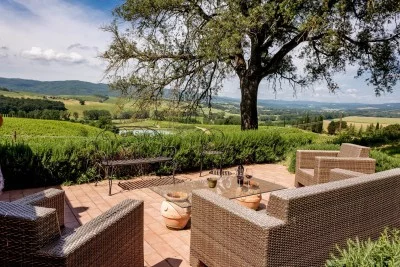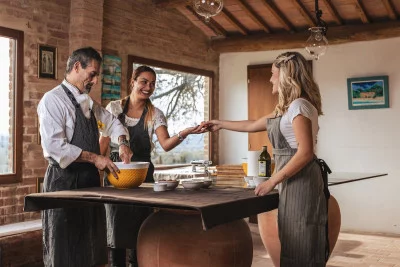Castello Tricerchi
(Weingut in Montalcino, Val d'Orcia)
Bewertungen
Vino e panorami
Stefano
Bellissima esperienza
Gabriele
Super
Francesca
Bello ma poco
Walter
Piacevole distrazione
Laura
Gustare vini e sapori unici in un castello incantevole.
Consigliamo a chiunque volesse di visitare questo posto e, soprattutto, di degustare i loro vini.
Sibilla
Completo
Oltretutto il cibo offerto era veramente abbondante e di qualità
Chiara
Esperienza da provare
Lorenzo
Un posto magico
Il castello è davvero un gioiellino, ma ciò che ha reso speciale la nostra esperienza è senza dubbio la ragazza che ci ha guidato nel tour!
Martina (se non ricordo male questo è il suo nome) è stata super carina ed ha reso la visita molto interessante e per niente noiosa!
I ragazzi che gestiscono l’azienda sono giovani e pieni di grinta..insomma sanno il fatto loro!
Al castello Tricerchi si respira tutta la passione e l’energia che questi ragazzi mettono nel loro lavoro!
Visita consigliatissima!!
Alessia
Bellissima esperienza
Giulia
Great wine. Very interesting historical castle.
Quelle: google Gary Williamson
Fantastico
Quelle: google Ewa Olszewska
Lavoro in questo posto e vi posso...
Quelle: google Diego Luculli
Ein Erlebnis buchen
Über das Weingut und die Weine
The estate is situated on the north side of Montalcino and extends for 400 hectares, of which thirteen are cultivated as vineyards. In the centre stands the castle, originally built in the thirteenth century by the Altesi family and completed in 1441 by the Tricerchi family. It served as a fortress for pilgrims marching to Rome on the Francigena road. Many of its decorative and structural features have been attributed to Baldassare Peruzzi. In the sixteenth century the castle was occupied for a time by the Spanish who made it their own stronghold. Until it went back into the hands of the Tricerchi’s when it once again became a fortress for pilgrims on their way to the Vatican. It was during the sixteenth century that the chapel, originally located within the fortified walls (as demonstrated by the presence of the belfry), was relocated to the path to the front of the castle and dedicated to the Virgin of the Veil. A fragment of the Veil, certified by a Papal Bull, is still in the church. In 1982 the Altesi castle was declared as an artistic and historical heritage site.
The hillside underlying the castle is covered with vineyards that extend to the lake below which, in ancient times was used to supply domestic water for irrigation. The vineyards are divided into seven plots, each cultivated in the same way with the vines cordon trained. They are ‘The Veil’, ‘The Castle’, ‘Sant’ Anna’, ‘The Lake’, ‘The Cypress’ and ‘The New Vineyard’.




